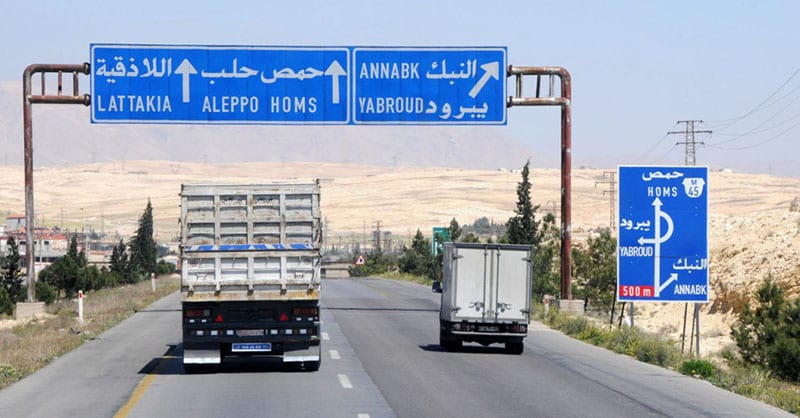
68,000+ km Road Network A vast foundation ready for modernization
2,050 km of Rail Lines Built-in infrastructure for efficient freight
23.5M Tons Maritime Throughput (Pre-War) Ports primed to support regional trade again
5.5M Air Passengars (2010) Proven demand for reactivated air mobility
Transportation is the circulatory system of any economy. In Syria, reestablishing modern, reliable logistics networks is essential both for delivering essential goods today and for unlocking national trade, investment, and stability tomorrow.
Syria once boasted a 782 km highway network, over 97,000 km of roads (61,500 paved), and the 2,052 km Syrian Railway system—critical arteries for people and commerce alongside major highways M5 and M4 en.wikipedia.org+10lca.logcluster.org+10dailysabah.com+10en.wikipedia.org. Yet years of conflict damaged over half the rail network (1,500 km), degraded major roads, and paralyzed critical public services like vehicle registration and logistics oversight dailysabah.com.
However, a renewed push is underway. In 2025, the Transport Minister declared that restoring routes linking Syria with Turkey, Iraq, Jordan, and Lebanon is a strategic priority—positioning the country as a regional transportation hub en.wikipedia.org+9dailysabah.com+9linkedin.com+9. Rehabilitation efforts are rapidly gaining steam: sections of the M5 have reopened, Ankara has conducted rail inspections, and port upgrades are underway at Latakia for CMA CGM’s €230 million terminal investment en.wikipedia.org.
This network revival is not just about roads and rails—it’s about enabling every sector of Syria’s reconstruction journey.
Road & Expressway Development
Damascus-Homs-Aleppo (M5) and coastal M4 routes are being restored for civilian use. Reconstructing, widening, and resurfacing these roads can reduce transport costs, improve security, and reconnect regional corridors.
Rail Infrastructure & Freight Revival
Nearly 1,500 km of rail lie dormant. Reviving connections—like the Istanbul–Damascus historic rail or Baghdad corridor—will unlock freight corridors and enable cross-border trade, bolstered by improved rolling stock and signal systems.
Logistics Hubs & Cold-chain Facilities
With Syria’s ports—including Latakia (8 million tons annual capacity)—coming back online, there is a rising need for warehousing, intermodal yards, refrigeration, and bonded zones to support agribusiness and manufacturing exports tcf.org+5dailysabah.com+5euronews.com+5lca.logcluster.org+2linkedin.com+2au.news.yahoo.com+2openknowledge.worldbank.org+1tcf.org+1.
Border & Transit Corridor Modernization
The country’s strategic geography offers a once-in-generation opportunity to upgrade border logistics, transit rights, and customs cooperation—leveraging its role as a bridge to the Gulf and Europe .
Tech-Enabled Freight & Mobility Services
There is untapped capacity for digitized trucking, tracking platforms, public transport restoration, and vehicle-registration systems to streamline logistics and support workforce movement.
61,500 km paved roads (out of 97,400 km total)
2,052 km rail system, with ~1,500 km out of service
M5 (450 km) and M4 (120 km) expressways linking key economic nodes
Port of Latakia handles ~8 million tons annually; new €230M terminal underway
84% drop in exports since conflict highlights need for reliable logistics en.wikipedia.org+1lca.logcluster.org+1en.wikipedia.orgunescwa.org
Every sector benefits from logistics resilience:
Agriculture & Agribusiness—farm output travels faster, fresher, farther
Manufacturing & Textiles—supply chains reactivated through efficient transport
Hospitality and Tourism—roads feed coastlines and heritage sites
Energy & Infrastructure—network capacity expanded through corridor upgrades
Restoring transport isn’t just an element of reconstruction—it’s the backbone without which no other sector can fully operate or grow.
Through the U.S.-Syria Business Council, U.S. and Syrian partners are engaging across transportation modalities:
Identifying PPP road and rail restoration packages, including expressway resurfacing
Exploring logistics hub investments, cold storage, and freight terminals
Participating in transit corridor dialogues with Iraq, Jordan, Turkey, and Lebanon
Bringing tech-led solutions for vehicle management, trucking platforms, and last-mile distribution
Transportation & Logistics is the sector that ensures everything else moves—join the Council to help rebuild Syria’s economic arteries for stability, trade, and growth.